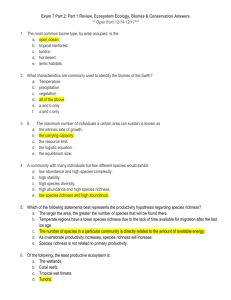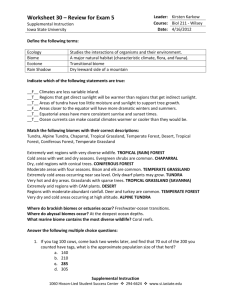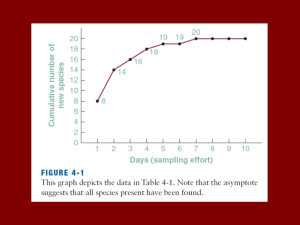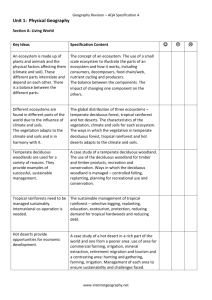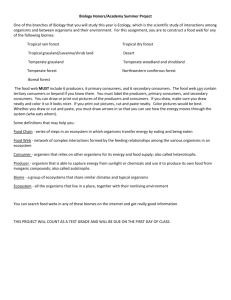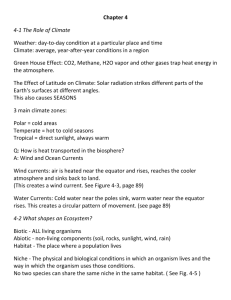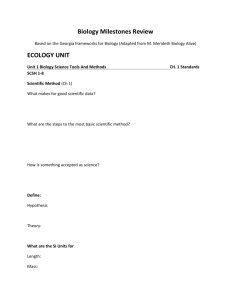Ecology Practice Exam
advertisement
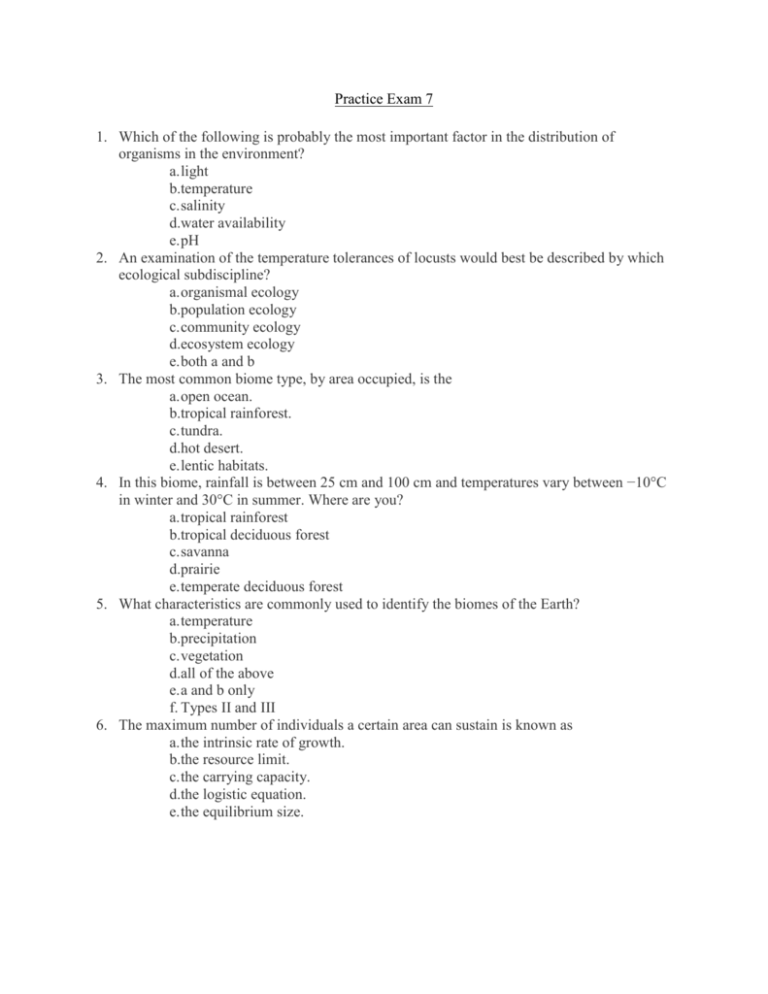
Practice Exam 7 1. Which of the following is probably the most important factor in the distribution of organisms in the environment? a. light b.temperature c. salinity d.water availability e. pH 2. An examination of the temperature tolerances of locusts would best be described by which ecological subdiscipline? a. organismal ecology b.population ecology c. community ecology d.ecosystem ecology e. both a and b 3. The most common biome type, by area occupied, is the a. open ocean. b.tropical rainforest. c. tundra. d.hot desert. e. lentic habitats. 4. In this biome, rainfall is between 25 cm and 100 cm and temperatures vary between −10°C in winter and 30°C in summer. Where are you? a. tropical rainforest b.tropical deciduous forest c. savanna d.prairie e. temperate deciduous forest 5. What characteristics are commonly used to identify the biomes of the Earth? a. temperature b.precipitation c. vegetation d.all of the above e. a and b only f. Types II and III 6. The maximum number of individuals a certain area can sustain is known as a. the intrinsic rate of growth. b.the resource limit. c. the carrying capacity. d.the logistic equation. e. the equilibrium size. Questions 7 and 8 refer to the following generalized growth patterns as plotted on arithmetic scales. Match the following descriptions with the patterns indicated below. Each pattern may be used once, more than once, or not at all. 7. Which pattern is found where a population exhibits a constant per capita growth rate? a. A b.B c. C d.D e. none of the above 8. Which pattern is found where a population is heading toward extinction? a. A b.B c. C d.D e. none of the above 9. A community with many individuals but few different species would exhibit a. low abundance and high species complexity. b. high stability. c. low species richness and high abundance. d. high species diversity. e. high abundance and high species richness. 10. Which of the following statements best represents the productivity hypothesis regarding species richness? a. The larger the area, the greater the number of species that will be found there. b. Temperate regions have a lower species richness due to the lack of time available for migration after the last ice age. c. The number of species in a particular community is directly related to the amount of available energy. d. As invertebrate productivity increases, species richness will increase. e. Species richness is not related to primary productivity. 11. A species interaction in which one species benefits but the other species is unharmed is called a. mutualism. b. amensalism. c. parasitism. d. commensalism. e. mimicry. 12. According to the competitive exclusion hypothesis, a. two species that use the exact same resource show very little competition. b. two species with the same niche cannot coexist. c. one species that competes with several different species for resources will be excluded from the community. d. all competition between species results in the extinction of at least one of the species. e. none of the above is correct. 13. The amount of energy that is fixed during photosynthesis is known as a. net primary production. b. biomagnification. c. trophic-level transfer efficiency. d. gross primary production. e. production efficiency. 14. Chemoautotrophic bacteria are a. primary consumers. b. secondary consumers. c. tertiary consumers. d. primary producers. e. decomposers. 15. When considering the average food chain, which of the following statements is true? a. Secondary consumers are the most abundant organisms in an ecosystem. b. The more lengths in the food chain, the more stable the ecosystem. c. Biomass decreases as you move up the food chain. d. The trophic level with the highest species abundance is usually the primary producers. e. All of the above are true. 16. Primary production in aquatic systems is limited mainly by a. temperature and moisture. b. temperature and light. c. temperature and nutrients. d. light and nutrients. e. light and moisture. 17. The net primary production of cultivated land is closest to that of a. prairies. b. tropical rain forest. c. wetlands. d. temperate deciduous forest. e. lakes and streams. 18. Terrestrial primary producers acquire the carbon necessary for photosynthesis from a. decomposing plant material. b. carbon monoxide released from the burning of fossil fuels. c. carbon dioxide in the atmosphere. d. carbon sources in the soil. e. both a and d. 19. Nitrogen fixation is the process a. that converts organic nitrogen to ammonia. b. by which plants and animals take up nitrates. c. by which bacteria convert nitrate to gaseous nitrogen. d. by which atmospheric nitrogen is converted to ammonia or ammonium ions. e. all of the above 20. Which of these factors is not generally correlated with species diversity? a. Latitude b. Productivity c. Longitude d. Island size 21. Which of the following ecosystems would you expect to have the highest primary production? a. Subtropical desert b. Temperate grassland c. Boreal forest d. Tropical dry forest 22. Most of the net primary productivity is consumed is used for what purpose? a. Respiration by primary consumers b. Respiration by secondary consumers c. Growth by primary consumers d. Growth by secondary consumers


